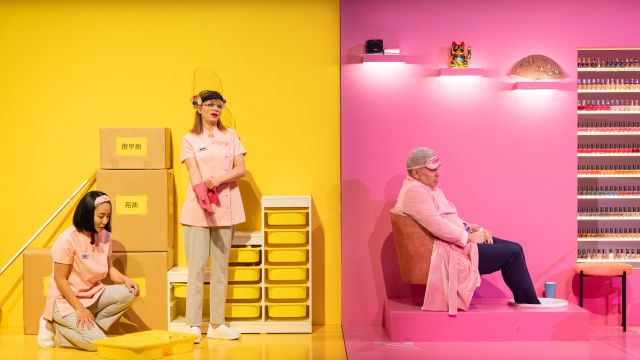Top Coat
Contrast and comedy come together in this perspicacious production that uses the ‘body swap’ genre to take a shrewd look at social order and the multitude of contemporary issues that stem from ingrained attitudes, classism and media representation and how that affects the way we treat others – be that someone who puts the ‘top coat’ on our nails; or the way we climb ruthlessly over others on the way to reach the ‘glass ceiling’.
In Top Coat Michelle Law – playwright, journalist, speaker – uses the theatre to make astute comments about the impact of white privilege across our society, from the beauty industry to the media. She explains this perceptively in her reflections about writing the play:
“I was also able to reflect on the impact that representation has on the lives of people of colour, and how the systematic racism stitched into the fabric of this country since colonisation has led to a largely monocultural media landscape controlled by white leaders who, despite their good intentions, often cause deep harm”.

These are weighty words – yet in her play Law skilfully uses the veil of comedy to depict situations that are sardonically real, and characters that develop through dialogue that judiciously reveals layers of inherent racist attitudes, perceptions of social status and the tokenism to diversity practised in the arts.
Proselytising is avoided by the fast pace dictated by the writing and the comedy that osmoses through every scene. Realistic characters are juxtaposed with comedic caricatures. And a realistic situation is upended by a strange, paranormal electrical intervention that is the thesis of the plot – namely two characters switching bodies and having to negotiate each other’s life.

Winnie (Kimie Tsukakoshi) is a manicurist saving to afford her own salon, whilst constantly facing unthinking condescension and racism. Kate (Amber McMahon) is an acerbic executive at MBC, a television company. Kate is confident, pushy and blissfully unaware of her flagrant, insensitive discrimination. Their lives are as different as their workplaces – as they find when their bodies are magically ‘swapped’ – thus providing a perfect scenario for a clever playwright like Law to comment adroitly on racism, social structure, and representation in the arts industry – and for an intuitive director like Courtney Stewart to realise the staging possibilities that the scenario suggests.
With designer James Lew, Stewart has commissioned a set that moves as constantly as the action. Carefully braced flats on smoothy moving trucks are slickly manipulated by the cast and crew to depict a variety of scenes. They twist and turn, meet, join, then swing away again. They are bright and colourful, their ‘role’ in the play accentuated by designers Kate Baldwin and Michael Toisuta and their cleverly co-ordinated lighting and sound effects.

The choreography in this production depends on split second timing. The actors and stage crew work in synch. Costumes changes occur as pieces of the set are moved. The set becomes a ‘built in’ extension of the theme of the play. Actors and set, cast and crew move constantly together. If ever a play depended on ensemble work, this is one!
Kimie Tsukakoshi and Amber McMahon work skilfully inside Winnie and Kate’s skins to establish the ‘power shift’ that Law wants the audience to consider.

Tsukakoshi mixes deference with pique to show Winnie’s reaction to unthinking racism and arrogance. She moves lightly on the stage, clarifying her character with elegant poise and restrained irritation.
McMahon uses similar poise to establish Kate’s confidence and self-assurance. She works with impressive command to make Kate stridently haughty, over-confident, oblivious to the hurt her condescension causes.
As their roles are reversed, Tsukakoshi steps Winnie confidently into Kate’s shoes but with less ego and more understanding. And Kate, in Winnie’s shoes, finds just how intimidating condescension can be.

Comedic timing is essential in Law’s lines and Stewart’s direction – and both Tsukakoshi and McMahon make the most of every comic line and interaction.
As do the three actors who play the characters who people Winnie and Kate’s lives. Arisa Yura has the interesting task of playing Winnie’s fellow beautician, Asami – and Yura, the Japanese-Australian screenwriter at the television company, whose work is overlooked. She makes her ‘role swap’ via clever writing rather than “lights and drum rolls” and makes both roles distinctly different and yet, in keeping with the irony, suggestively similar. Clever writing – and clever characterisation.

John Batchelor plays several roles, each skilfully played to augment the satire that is intrinsic to Law’s purpose. He plays Kate’s pompous boss Barry, her partner Jeremy and several of Winnie’s clients. Batchelor’s experience across stage and screen is extensive, all of which is evident in the intricate changes he uses to make each of these characters very different – yet equally funny.
Matty Mills plays Marcus, the indigenous Business Affairs Executive at the Television company, as well as other characters that support the action. Mills too has an instinct for comedy – and timing – as well finding the various dimensions that Law manages to build into all her characters.
Top Coat brings together a cast and crew representative of a multicultural Australia that is seldom represented on the stage. The play is written, directed and designed by Asian-Australians. Two of the cast are also Asian-Australians. One is indigenous. That makes a distinctive comment about representation. It boldly investigates a host of complex social inequities, but does so in a way that makes us laugh – albeit uncomfortably.

“Ultimately, this piece demands a higher standard for the ways people of colour are represented in the stories we see on stage and screen … Top Coat gives us all an opportunity to find our way back to each other”. (Courtney Stewart, Director).
Carol Wimmer
Photographer: Daniel Boud
Subscribe to our E-Newsletter, buy our latest print edition or find a Performing Arts book at Book Nook.

